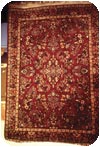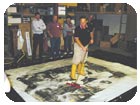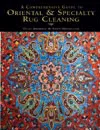Oriental Rugs and Disaster Restoration

Rugs impacted by a disaster involving water or smoke damage can often be salvaged. The homeowner or insurance company may request heroic action due to the value of certain Oriental rugs. This type of salvage cleaning should be carefully pre-qualified with all parties due to the many variables in rug dyes, construction, fibers, type of fire, etc. Many times, rugs are permanently damaged not from an incident, but from improper handling.

Be aware that soot can deposit in such a fashion as to conceal the full extent of the contamination until an area is cleaned to provide comparison. Oriental rugs often lay under furniture that shields some areas of the rug from soot fallout while other areas are left exposed. The efficacy of cleaning is judged by comparing protected to exposed areas after cleaning.
Soot becomes harder to remove over time. Process smoke-damaged rugs as soon as possible. Don’t touch; human body oils, when combined with smoke residue, will make soil removal more difficult. Always wear cotton work gloves when handling smoke-damaged rugs.
If the rug is dry, vacuuming must take place on-site prior to the item being touched, packed or moved. Avoid exerting pressure in the initial vacuuming; consider using a canister vacuum with a suction tool and hovering over the rug to minimize smearing or impacting the residue into the rug’s surface.
If the rug is wet with no fire residue, do the following:
- Extract as much water as possible on-site.
- Transport the rug to the shop; to do so, first place plastic on the ground and put the rug on top of the plastic. Roll the rug up with the plastic; this keeps the rug from transferring dye onto itself and also protects the outside of the rug from getting dye stains from other wet rugs it may come in contact with in the truck.
- If one does not have a rug-cleaning plant or you have no access to one on a weekend, the most important thing to do is get the rug dry as quickly as possible with water-extraction equipment. Drying the rug flat is safest, to help prevent color bleeding. Air movers should be placed underneath the rug. Rugs can be also dried flat outside in the sun to hasten drying.
If the rug is wet with fire residue, before extracting the water, remove as much fire residue as possible. This can be accomplished on-site using a broom followed by dry extraction. Once the rugs are in a shop, use any combination of vacuum, broom, compressed air, or automatic duster. The more particulate material removed before extraction and drying, the less likely the soot will leave carbon stains, which are usually impossible to remove. A significant amount of residue can be removed in the shop by hosing down the rugs with water. Either proceed with cleaning, or dry flat if taking the rug to someone else to clean.
If the rug has fire residue only:
- Remove as much fire residue as possible.
- Roll the rug up with plastic as outlined above.
- Unroll the rugs at the shop and let them “air out” if you are not able to get them cleaned immediately.
- Hose the rugs down with water, if possible, then clean and dry flat.

The most thorough method to remove smoke odors is to soak the entire rug in a wash pit with water and a good smoke deodorizer. Even after soaking, there is no guarantee that the entire odor will be eliminated. It is my experience that spraying a topical treatment alone is not enough to remove most of these odors, but soaking has a 90 percent to 95 percent success rate.
Soaking rugs is very effective for odor removal, but also requires a higher level of rug knowledge. Not all rugs can be soaked as there may be bleeding, delamination or shrinkage that can occur with soaking that may not occur with regular cleaning.
Total Loss
Excessive dye bleeding. Small areas of dye bleeding can often be removed but there is a point of diminishing returns when the cost to restore the rug is more than its worth.
Numerous scorches. Some rugs will be worth re-weaving if the area is small.
Shrinkage with buckling. The foundation of some rugs will shrink when wet and cause buckling. Usually, this is not correctable if severe.
Looking for a reprint of this article?
From high-res PDFs to custom plaques, order your copy today!




